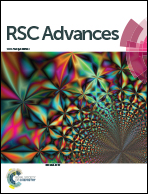A bifunctional sensor based on diarylethene for the colorimetric recognition of Cu2+ and fluorescence detection of Cd2+†
Abstract
A novel bifunctional sensor based on diarylethene with a benzyl carbazate unit was synthesized successfully. It not only served as a colorimetric sensor for the recognition of Cu2+ by showing changes in absorption spectra and solution color, but also acted as a fluorescent sensor for the detection of Cd2+ through obvious emission intensity enhancement and fluorescence color change. The sensor exhibited excellent selectivity and sensitivity towards Cu2+ and Cd2+, and the limits of detection for Cu2+ and Cd2+ were 8.36 × 10−8 mol L−1 and 1.71 × 10−7 mol L−1, respectively, which were much lower than those reported by the WHO and EPA in drinking water. Furthermore, its application in practical samples demonstrated that the sensor can be effectively applied for the detection of Cu2+ and Cd2+ in practical water samples.



 Please wait while we load your content...
Please wait while we load your content...